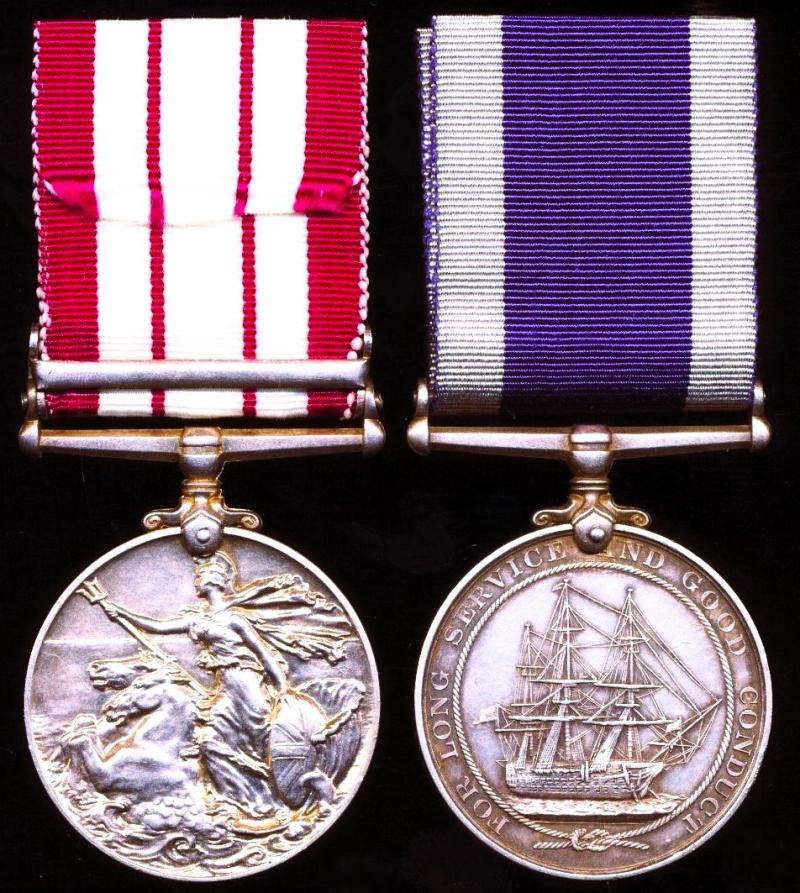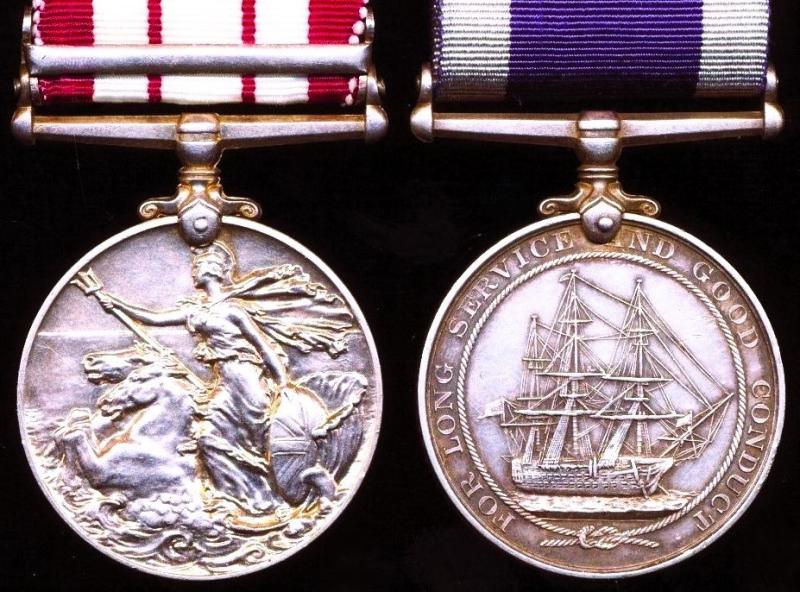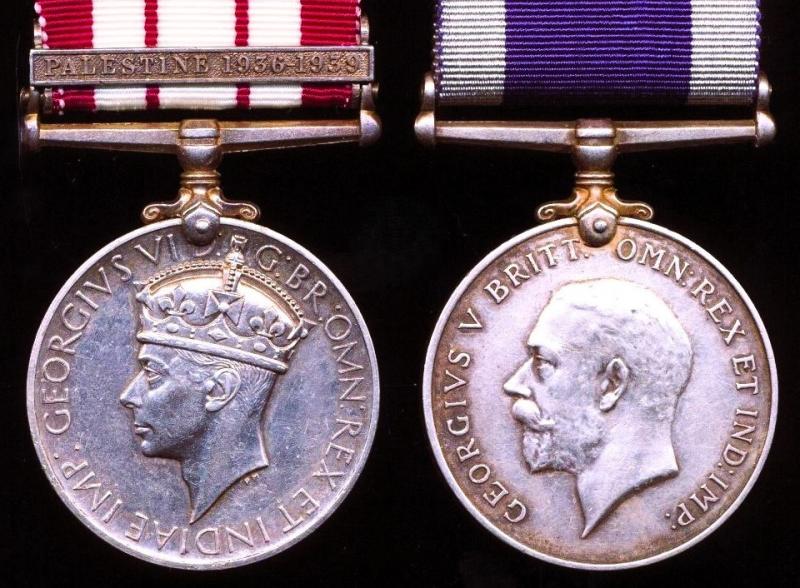A Naval campaign & long service medal pair to a Chief Stoker who served on the Battleship H.M.S. Warspite - the most decorated warship of the Royal Navy 1939-45: Chief Stoker Walter Charles Harber, H.M.S. Warspite, late Royal Marine Light Infantry
- Naval General Service Medal 1915-62. With clasp 'Palestine 1936-1939' (K.62213 W. C. Harber. Ch. Sto. R.N.)
- Naval Long Service & Good Conduct Medal. GV 'Coinage Head' issue (K.62213 W. C. Harber. Ch. Sto. H.M.S. Sussex.)
Medals and clasp verification: The recipients entitlement to the NGS medal and clasp & Naval LSGC is confirmed as entitled per endorsements on the recipients extant Naval Service Sheets (held and accessible at The National Archives). The Naval campaign medal rolls for the Second World are not yet in the Public Domain, and service sheets for the period 1939-46 do not include details of campaign stars or medals awarded during the conflict. Notwithstanding the paucity of accessible medal records, the probable full medal entitlement of the recipient is:
- NGSM 1915-62. 'Palestine 1939-36': Recipients service sheet endorsed 'A. Wd. N.G.S. (Palestine) Medal' with issue date 2/9/41. Served on H.M.S. Sussex
- The 1939-45 Star. No clasp. Confirmed entitled per 6 months operational service with H.M.S. Sovereign
- The Atlantic Star. With clasp 'France & Germany': Confirmed entitled per service with H.M.S.
Sovereign (clasp could have been earned with Warspite (Normandy Landings /Walcheren)
- The Africa Star: Confirmed entitled while serving with H.M.S. Sovereign
- The Italy Star: Possibly awarded while serving with H.M.S. Warspite which ship is confirmed entitled
- Burma Star. No clasp: Confirmed entitled serving with H.M.S. Warspite in 1942
- War Medal 1939-45: Confirmed entitled for 28 days uniformed service between 1939-45
- Naval LSGC. GV Coinage Head issue: ADM. His service sheet shows 'Traced Medal' 15 August 1935
H.M.S. Sussex: During the 'Arab Revolt' in the Palestine Mandate Territory 1936-39, crew members from the heavy cruiser H.M.S. Sussex, were deployed ashore where amongst other duties, they manned an 'Armoured Train' that was equipped with Pom-Pom guns from 'Sussex'. See 'Getty Images' for a splendid photograph of the crew from H.M.S. Sussex manning an 'Armoured Train' in Palestine, 1936
H.M.S. Royal Sovereign: At the outbreak of the Second World War in September 1939, the battleship 'Royal Sovereign' was assigned to the Home Fleet, the ship was tasked with convoy protection until May 1940, when she returned to the Mediterranean Fleet. Royal Sovereign was present during the Battle of Calabria in July 1940, but her slow speed prevented her from engaging the Italian battleships. By March 1942, she was assigned to the Eastern Fleet in the Indian Ocean, but after the Indian Ocean raid by Admiral Nagumo’s Kido Butai, the ship was withdrawn to eastern Africa to escort convoys. In January 1944, she returned to Britain, and in May the Royal Navy transferred Royal Sovereign to the Soviet Navy, which renamed her Arkhangelsk. She then escorted Arctic convoys into Kola until the end of the war. The Soviets returned the ship in 1949, for scrapping
H.M.S. Warspite: During the Second World War, the battleship Warspite was involved in the Norwegian Campaign in early 1940 and was transferred to the Mediterranean later that year where the ship participated in fleet actions against the Royal Italian Navy (Regia Marina) while also escorting convoys and bombarding Italian troops ashore. She was damaged by German aircraft during the Battle of Crete in mid-1941 and required six months of repairs in the United States. They were completed after the start of the Pacific War in December and the ship sailed across the Pacific to join the Eastern Fleet in the Indian Ocean in early 1942. Warspite returned home in mid-1943 to conduct naval gunfire support as part of Force H during the Italian campaign. She was badly damaged by German radio-controlled glider bombs during the landings at Salerno and spent most of the next year under repair. The ship bombarded German positions during the Normandy landings and on Walcheren Island in 1944, despite not being fully repaired. These actions earned her the most battle honours ever awarded to an individual ship in the Royal Navy. For this and other reasons, Warspite gained the nickname the "Grand Old Lady" after a comment made by Admiral Sir Andrew Cunningham in 1943 while she was his flagship in the Eastern Fleet
The recipients extant 3 x sets of Royal Marines & Royal Navy service sheets confirm all of above service. Showing that he served with H.M.S.Sussex (1934-1938); the battleship H.M.S. Sovereign 17 February 1938 to 8 August 1941, and the last ship shown as serving with the battleship H.M.S. Warspite from 21 November 1941 with note that he qualified for pension while serving on Warspite, with date, 21 November 1942. This latter date not refer to his retirement from the Navy, just when he had completed his 21 years service. He would of course continue to serve for the duration of hostilities, with his service sheet finally endorsed 'Released to Class A' on 8 October 1945, on which date he left the Royal Navy
Walter Charles Harber, son of Walter George Harber, was born in Bermondsey, London, on 22 November 1901. He joined the Chatham Division of the Royal Marine Light Infantry on, 21 June 1920, prior to which he had been employed as a General Labourer. As a Marine, he served aboard the battleship H.M.S. Marlborough, 24 January 1934 to 8 August 1924. Thereafter he transferred his service to the Royal Navy, joining the 'Senior Service' as a 'Stoker' Second Class on 9 August 1923. He was posted to H.M.S. Sussex on 25 July 1934, and was advanced Chief Stoker on 12 August 1934, being awarded his Long Service and Good Conduct Medal aboard H.M.S. Sussex, on 15 August 1935, and the following year qualifying for his NGS Medal, for service in Palestine while a member of the crew of H.M.S. Sussex. During the Second World War, Walter has extensively deployed, serving aboard the battleships, H.M.S. Royal Soverign, and latterly from 1941 on H.M.S. Warspite - the latter being the most decorated warship of the Royal Navy 1939-45. Walter is recorded to have died at Lowestoft, Suffolk, England, on, 11 July 1969
A most desirable naval pair of medals representing a long record of active service aboard several capital ships of the Royal Navy
Condition: About GVF
Code: 24335







